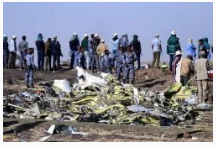
Ethiopian crash report highlights sensors, software, leaves questions

ADDIS ABABA/SEATTLE– Faulty sensor readings and multiple automatic commands to push down the nose of a Boeing plane contributed to last month’s fatal crash in Ethiopia, leaving the crew struggling to regain control, according to a preliminary accident report.
The first substantial account of the last minutes of Ethiopian Airlines flight 302 from Addis Ababa to Nairobi on March 10 described how the captain three times called out: “Pull up” and was acknowledged by the first officer, but to no avail.
Boeing’s top-selling aircraft, the 787 MAX, has been grounded worldwide since the March 10 disaster, which killed 157 people and came just five months after a Lion Air crash in Indonesia that killed 189 in a plane of the same model. Families of the victims, regulators and travellers around the world have been waiting for signs of whether the two crashes are linked, and the extent to which Boeing technology and the actions of the Ethiopian Airlines pilots played a role.
The doomed flight crashed six minutes after take-off from Addis Ababa in clear conditions. “Most of the wreckage was found buried in the ground,” said the report by the Ethiopian Civil Aviation Authority’s Accident Prevention and Investigation Bureau published on Thursday.(Reuters)…[+]








